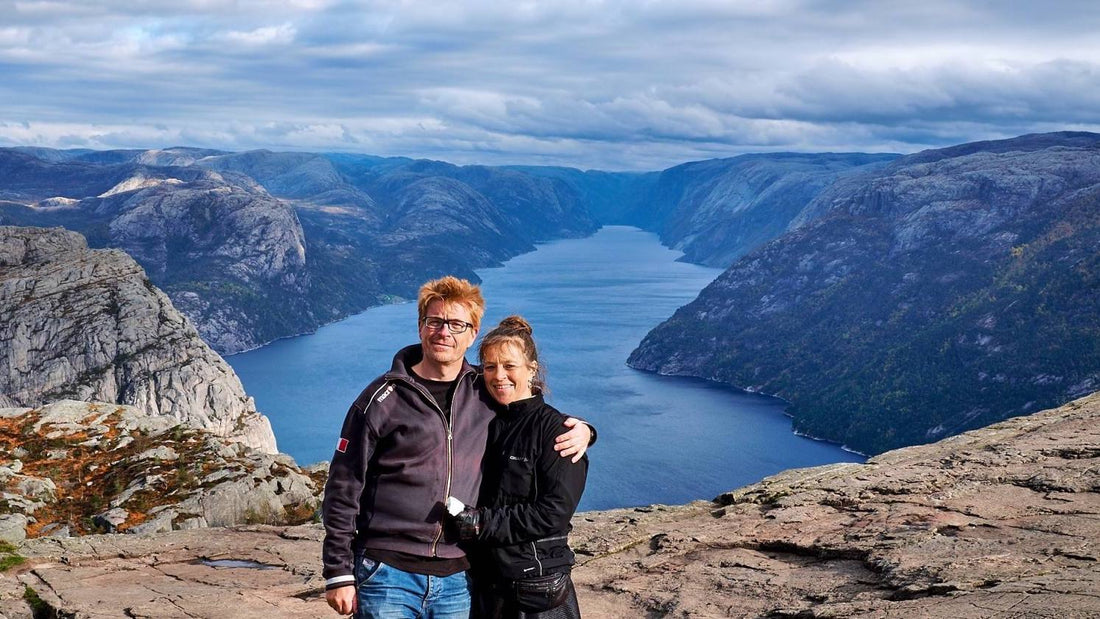
Imagine that you are hiking and climbing for two hours in rugged terrain, on steep rocks and cliffs, after which you continue over open plains with bog landscape, until you are suddenly one meter from an edge, with 600 meters vertical fall - how would you react?
I know exactly how I react, as that is what you experience on your walk to the pulpit in Norway. I admit that my heart was pumping a little faster and I was breathing a little - not just because of the breathtaking experience !. Along the way I also got a little jelly in my legs as the last hundred meters to the plateau itself is very very close to the edge.
When we got to the top, we sat far from the edge, just to get the air again, and look at the many people who did all sorts of crazy things on the 25 x 25 meter plateau, 600 meters above the Lysefjord.
This is a description of our hike to the Pulpit Rock in Norway, which we made in connection with our trip to Stavanger in 2015. A hike that requires a lot, but which is worth all the effort, in the form of the many beautiful photos you can take the trip to the plateau, and the wild view from the top of the pulpit.
Read on and get practical information about accommodation, the road to the Pulpit Rock, parking at the Pulpit Rock and more.
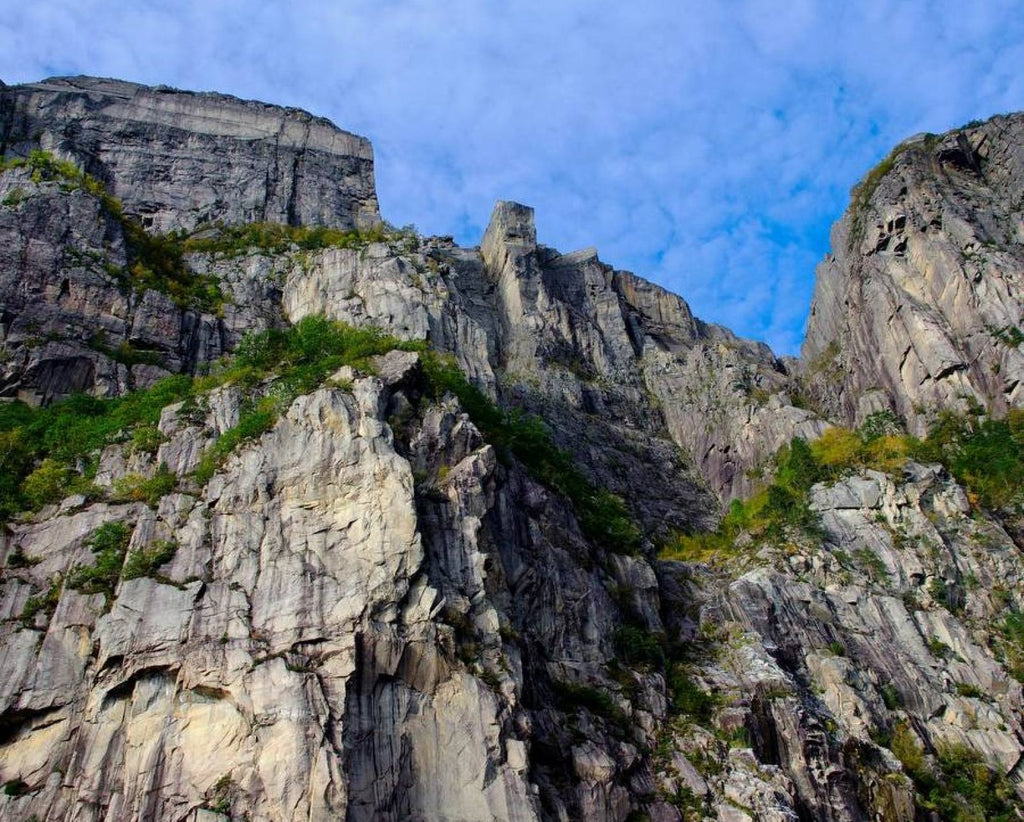
600 meter under the Pulpit Rock
How to get to the Pulpit Rock?
The Pulpit Rock, or Preikestolen, as it is called in Norwegian or Pulpit Rock, as it is called in English, is located in Ryfylke, an area east of Stavanger on the southwest coast.
Our hike to the Pulpit Rock in Norway was just one of the goals of our 2015 trip to Norwegian nature. We were driving in our own car, and spent the night at a hotel in Stavanger, from where it is very easy to get to the parking lot at the start of the official route to the top. You can either take a ferry from Stavanger to Tau, or, as we did, drive south of Stavanger to Lauvvik, from where there is a ferry to Oanes. The ferries in the Norwegian archipelago sail non-stop and are relatively cheap to use. From Stavanger to Tau it takes 40 minutes, while from Lauvvik to Oanes it takes 5 minutes - in our case, of course, the drive from Stavanger must be added. Parking in the official car park costs 100 NOK, for as long as you need. paid in a vending machine that accepts all possible credit cards. As far as I remember, parking is forbidden everywhere, outside the square - sooo.
If you are leaving without a car, it is still easy to get to the Pulpit. There is the cheap option to take the ferry from Stavanger to the rope, from where there is a bus connection, or the somewhat more expensive to take one of Lysefjord's tourist boats to Oanes, from where a bus is arranged. If you use the last option, collection for the return trip can also be agreed.
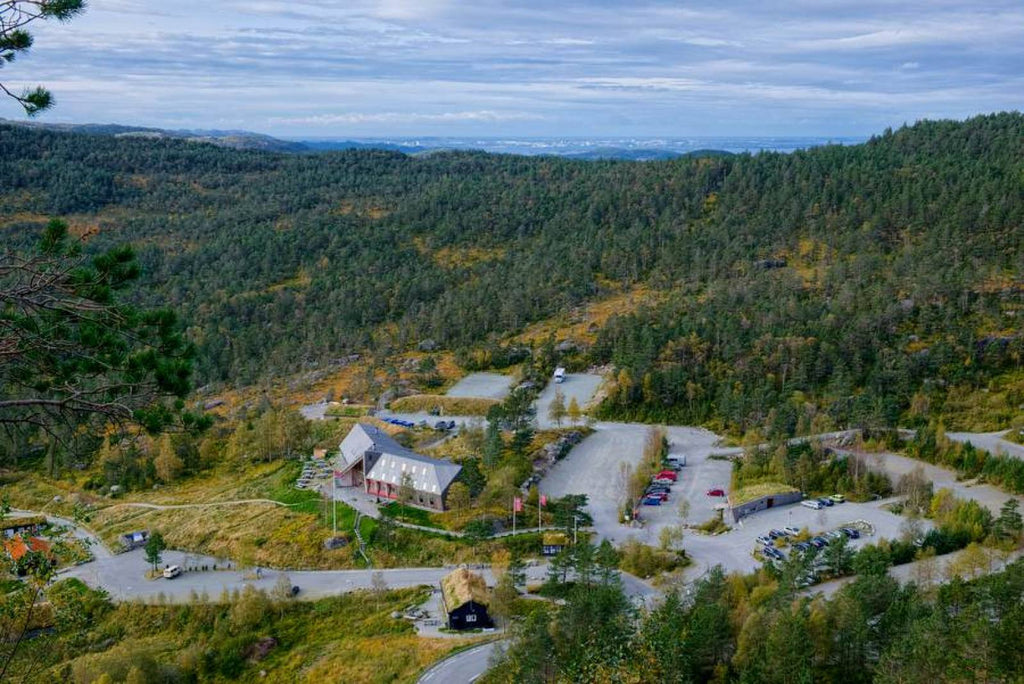
Pulpit Rock parking area
How hard is the walk to the pulpit?
A hike to the Pulpit Rock in Norway is a classic among Norwegian hikers. Even though the Norwegians do not consider the trip to be anything special, and a route has been laid out by Nepalese Sherpas, the trip to the top of the Pulpit or Pulpit requires that you are reasonably fit. The ride is not as tough as it looks in the movie Mission Impossible with Tom Cruise, but you need to be ready for a challenge.
If you are curious about how long the trip to the Pulpit takes, then it took for us about 2 hours up and about 2 hours down plus the time we spent at the top. It can therefore be very good to plan to start the trip relatively early in the day.
Before we started the upturn we got ready, by the car, but we were clearly "underdressed" in cowboy pants and dress - it was my wife in the dress;) - because around us people wore nice hiking clothes, hiking shoes, cool boots and big stuffed backpacks. We brought half a bag of almonds, two Kit Kat chocolate bars and half a liter of water, which was all plentiful. However, we had begun to think about whether we had prepared well enough for the trip when we started the trip towards the top. The trip is hard but does not require much equipment, we saw for example people in shoes with heels who climbed the steep rocks.
More about the actual walk to the Pulpit
From the parking lot you start by walking under an otherwise very little busy road, through a tunnel, and I just managed to think that it was an easy walk, but already very soon after it started to rise and not much more than 100 meters further on, I had to save a little on the talking clothes so I could breathe.
After a short walk on the first steep gravel road, there comes a piece with large pieces of granite that lie so that they form a kind of staircase with very high irregular steps. Among other things, these steps are made by Nepalese Sherpas. It is a typical Norwegian way to build paths in nature, which adapt beautifully to the surroundings, but in this case they have made use of foreign experts. Of course, the very high steps in granite are also a little harder to climb than a regular staircase. The hike to the Pulpit Rock was still just started and still relatively easy, but it is very long and I started to think that I would probably be tired before we reached the top.
Well up above the terraced piece of granite there is a flat piece of granite base, and then a little more flat granite, then a long walk on a footpath of wooden sleepers over a very swampy area. Then again a steep side with terraced granite pieces. The surface changes often, but most of the time you climb on granite pieces until you reach a large open area with small water holes formed in the hard granite foundation. The trip over this surface is long and all of a sudden all the way to the end you stand with your feet on the edge of a vertical drop of 600 meters. In the best Norwegian style, there is no protection, no signage, which just helps to enhance the experience of the raw nature.
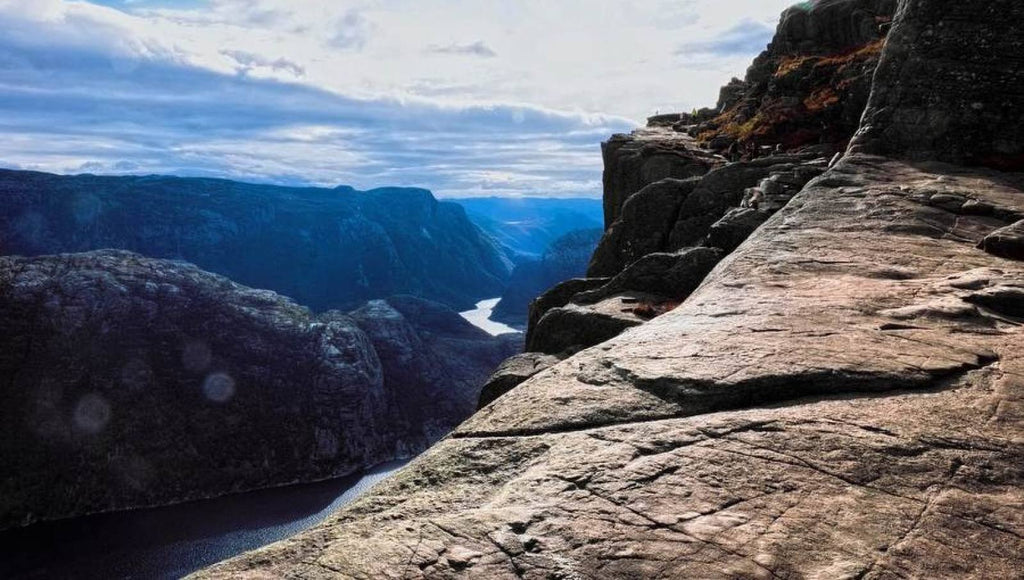
When you discover you are 600 meter above Lysefjorden
After trotting for more than 1.5 hours in safe and harmless terrain, it was a huge experience with suction in the stomach as we came to the free fall, and the view of the mountains that encircle Lysefjord was nothing short of breathtaking - absolutely amazing and worth the whole trip. Exactly at this point one discovers how one's body reacts to heights. My body was fine, but not as fine as the people who had the courage to sit with their legs dangling over the edge.
From the point where you reach the edge, there is still about 100 meters to the plateau Pulpit itself, and it takes place exclusively on a narrow path, where you practically walk on the edge of the mountain. On the narrow piece, I have to admit that my legs became liiidt soft. The plateau is about 25 x 25 meters, and we started out by sitting well in the background to inhale all the experiences, while we watched the people, of which single made, in our eyes, strange things out on the protrusion. Several sat with their legs over the edge, a young guy stood on one leg on the outer edge while a family let their, very young children, run around on the small surface. However, it must be said that most of them survive. Only a single death from the pulpit is known to date when a Spanish tourist fell in 2013.
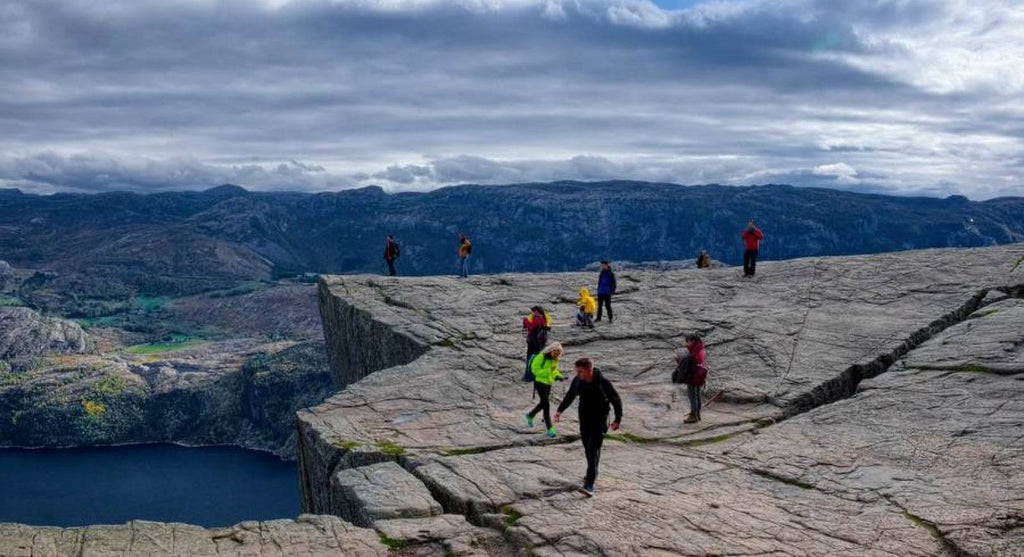
Tourista on the Pulpit Rock plateau
We spent a little hour photographing, getting photographed and looking at people before we decided to start our trip down again. We followed the marked route, but there should be alternative trips if you are up for it. However, we could not really find them, so after coming down the same road as we came up, and were back by the car, we had spent well over four hours. The legs were tired but in good condition. It is not a difficult hike and climb, but it is exhausting, so you must be prepared to hike and crawl for long periods. Even if we saw a few in strange footwear, we would advise good footwear with a good sole. I did the ride in sneakers and I was very sore under my feet, after walking on the many many sharp and pointed granite surfaces. My jumper knee was not completely satisfied either, but the trip was worth it all.
If you are in the area around Stavanger and Ryfylke, visit Prædikestolen or Preikestolen, in Norwegian, you will definitely not regret a hike to Prædikestolen in Norway. Happy hiking.

One of the easy parts

Stair made of big rocks
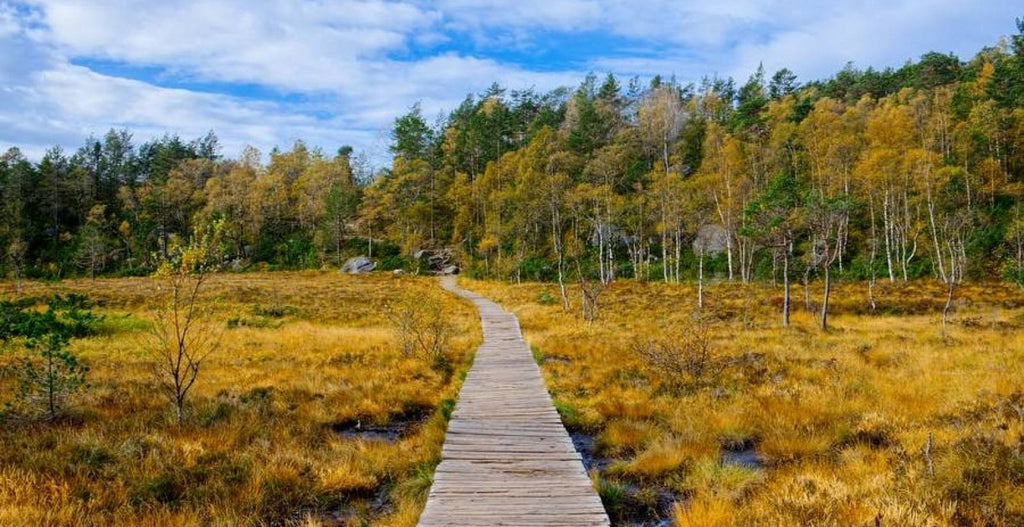
Wood bridge over the swamp
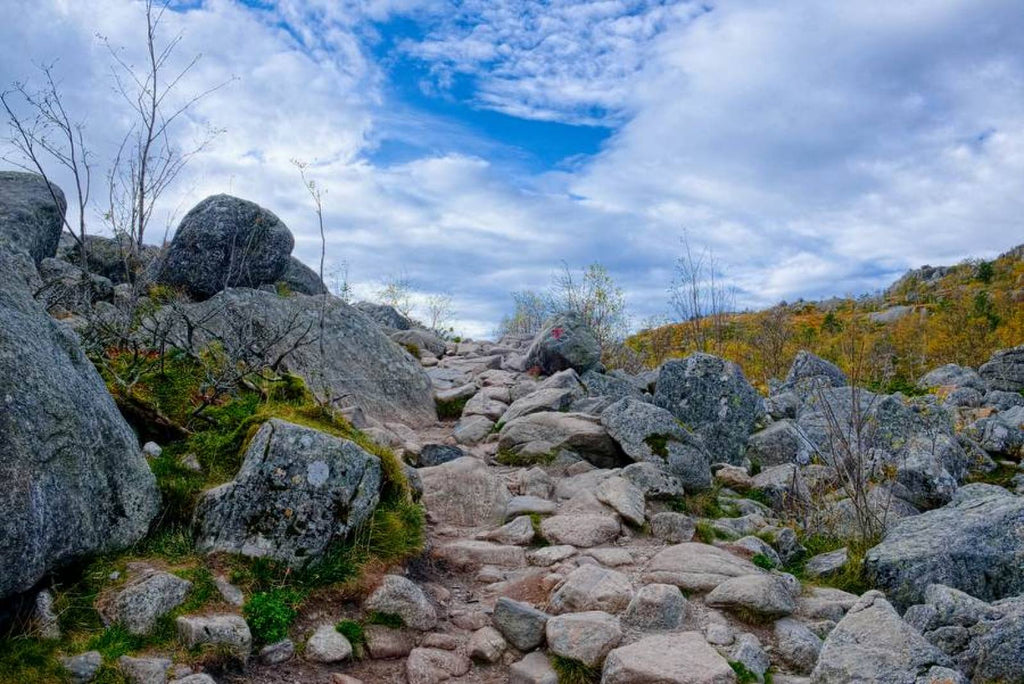
One of many slopes paved with rocks
PS: do not drive directly to Månefossen, where you also have to climb - here on completely slippery steep surfaces, where you pull up on ropes. It gives after bitter experience, very sore legs;)
A slightly lesser known hike, which in difficulty, is very reminiscent of that of the Pulpit, is a trip to the glacier Folgefonna. You do not get exactly the same rush as you do by standing at the vertical drop on the edge of the pulpit. On the other hand, you get really close to one of nature's more spectacular phenomena, namely a glacier.
Read more travel stories from Norway?
- Get really close to the Folgefonna glacier - if you can handle it
- Read here if it is worth visiting Old Stavanger
- Norway - the country with thousands of nature experiences
Finally, you are also very welcome to see our now large collection with posters with Norwegian motifs.

- We took the Prosecco route - Without touching a single drop of prosecco!
- Copenhagen - Italy, our first long trip in Europe in an electric car
- Hos PLAKATfar er vi eksperter i udsmykning af institutioner
- Guide to the many poster sizes and frame sizes
- Sådan kan plakater forvandle dit hjem - 10 tips fra PLAKATfar
- Travel guide from our trip to Båstnäs Car Cemetery or Ivan's Junk Yard
- Guide til ophængning af plakater og billeder
- Plakatfar udsmykker også institutioner
- Make your own picture wall
- Køb en ramme til din plakat og få gratis indramning
- Smart tip til at få store billeder, uden at betale en formue
- Color symbolism and the meaning of colors
- Travel guide from our hike to the Folgefonna Glacier
- Travel guide from our photo trip to the pulpit in Norway
- 5 bud på plakater, der hylder den danske sommer
- Prissammenligning af de billigste rammer til plakater og billeder
- Sådan sammensætter du let plakater og billeder
- Norge - et slaraffenland for naturelskere
- Old Stavanger - is it worth traveling for?
- Posters from Faroe Islands



